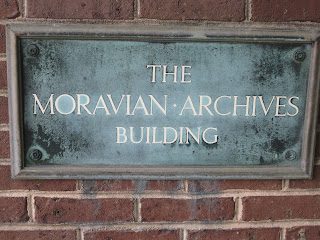My two last recent trips to the Moravian Archive involved delving into the lives of the Detterer Family- Frederick (1861-1893) and Caroline (Carrie,as she is sometimes addressed in her letters; d.1952 ) and their two surviving children Ernst and Pauline. Ernest's papers had already been approved, so I looked over those of the other Detterer family members.
I began with Pauline (1898-1982).
As noted in an earlier post, I do not spend a lot of time actually engaging with the documents themselves beyond verifying that they are represented accurately in the catalog; however, I was drawn into Pauline's life by a series of letters written to her by Ernst. The letters were jovial and big brotherly in nature- he chided her, recommended books, and wrote of his travels. He made vague references to incidents she described in her letters to him, but to me remain a mystery. And I was struck- not for the first time since I began working at the Archive- that some things are just constant and universal.
She also saved correspondence from other people in her life. RSVPs to parties and social gatherings she held- some from Lehigh students. There are two letters from Lawiston of Phi Sigma Kappa (511 Seneca St, South Bethlehem) that date from February 1917. He hoped to make arrangements to call upon Pauline. Another gentlemen wrote to Pauline to ask for her hand in marriage. From the proposal, Mr. Callen recognized that he was perhaps more infatuated with her than she with him- though he hoped for a positive answer, nonetheless. The second letter confirms that she had refused his offer. I wonder why she chose independence, as she remained unmarried her entire life. And I am also curious as to why she saved Mr. Callen's letters. If I had time, I would have liked to have to checked the dates of her saved letters against entries in her journals, which she wrote in daily between 1915 to 1971.
 |
| Pressed clovers from her journal 1925-1929 |
 |
| The letters from Lawiston, 1917 |
 |
| Travel Journal, 1963 |
 |
| The worst game of M.A.S.H ever |
 |
| Picture Postcard from Middleton, NJ |
 |
| Christmas Letter, San Jose, CA, 1909 |
Memtos her mother saved include sketch books, a napkin signed from her friends from the First Party of '05, cards from her children, wedding and graduation announcements, the obituary of her husband, doctor's notes & prescriptions related to her husband's illness, receipts, class notes, and the minutes of a club from school. Like Pauline, Caroline also wrote daily in journals. In her first one, she notes her excitement about starting a diary. In another, she lists the books she had read and one entry described a day trip to Atlantic City. Caroline appears to have always begun each entry with a few words about the day's weather.
 |
| A drawing from her sketch book. Her son Ernst became an art professor in Chicago. |
 |
| A Keepsake from her children |
 |
| A Keepsake from a party |
As I reviewed the documents of the Detterers, I was saddened as I thought about how the total of their lives had been collected and stored in the archival boxes. The complexity of a life lived reduced to saved keepsakes. And I wondered why certain items were saved. Obviously, some of the pieces had sentimental value and were purposefully kept by Pauline and Caroline. And other pieces seem almost accidental, like the receipts and prescription notes. Were these items tossed in a drawer, forgotten, and then gathered together after Pauline died to be deposited with the other material at the Archive? I can relate to that- I constantly toss random receipts into drawers to be dealt with at a later date. Or did those items have some unrecognizable value- were the prescriptions a link to Frederick or did the receipt record a meaningful purchase?
I know I cannot truly know these two women, though I do feel perhaps a kinship with them or an intimacy after pouring over their lives and reading things that they probably never intended to share with anyone else. According to Pauline's obituary, she is buried at Nisky Cemetery, which is a few blocks from my house. I hope to visit her soon.
One final note: I had shared some of the letters with one of the student catalogers when I first began the review of the project. Yesterday, we were both at the Archive again and she asked if I had discovered what the incident was that Ernst refers to in his earliest saved letter to Pauline. I had not. Our conversation, however, evolved into a discussion about twitter, texts, blogs, Facebook, and email. I honestly cannot remember the last time someone sent me a lengthy snail mail letter. Cards at Christmas and Birthdays sure, but an old fashioned hand written letter discussing intimate or not so intimate details of one's life- not since I was a kid. And honestly, it's been a month or so since I received an email of substantial length, longer since I've written one myself- I have a hefty backlog of emails to which I need to respond. Most of my daily exchanges with friends, who exist outside my everyday geography, are made through FB or texts- just snippets of lives and text that I often think give a false sense of connectivity. Occasionally, I keep a journal but not to the dedication that Pauline and Caroline did. I only write in one when I'm traveling abroad or when I have something I need to work through. I wonder when historians and archivists look back on this period of history what they will find to represent the everyday- what will be the ephemera and random saved mementos that document a life lived. How will they connect back to us as I connected to Pauline?





















